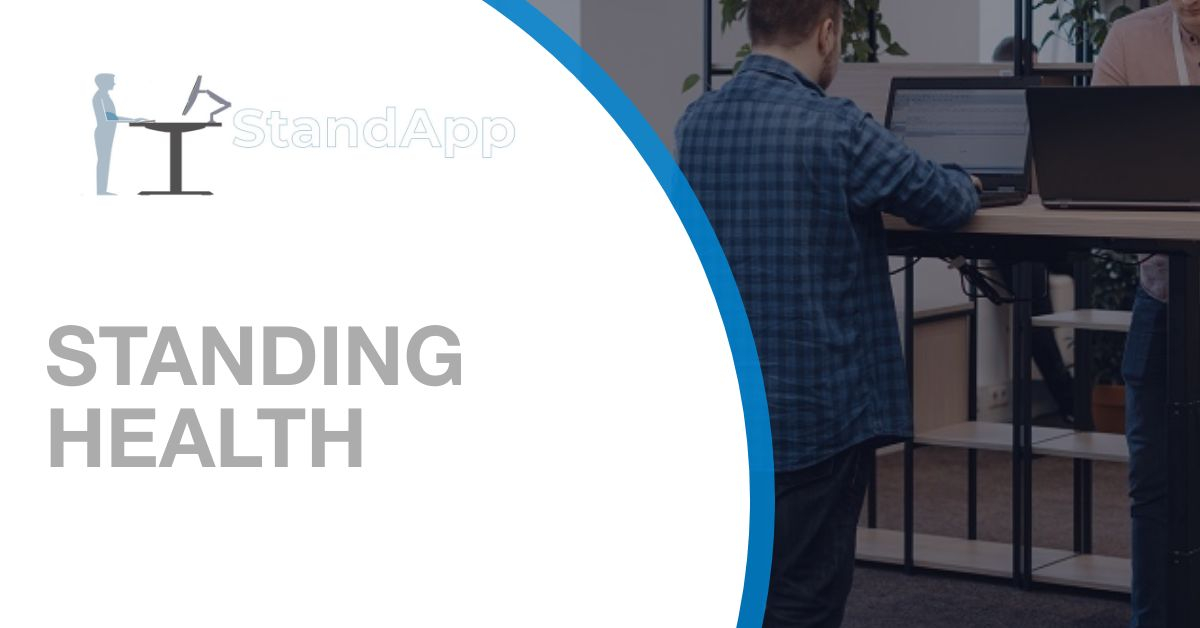
Standing Health
The problem with sitting
 Are you sitting too much? The human body, through evolution is designed to move. This seems at odds with technological advancement in recent decades and the resulting increase in sedentary lifestyles that are being adopted.
Are you sitting too much? The human body, through evolution is designed to move. This seems at odds with technological advancement in recent decades and the resulting increase in sedentary lifestyles that are being adopted.
For years, until the computer revolution the workplace was varied and by and large active. In the preceding years, motorized vehicles and TV’s began to replace cycling and sports as activities humans indulged in. This began a slow chipping away of physical activity in our daily lives.
In 2013, a survey performed by Ergotron found that around 70% of American, although they hated sitting, it was required for their vocation. From office workers to programmers, most of use a computer for work and this means the need to sit. This has led to a new adage, that ‘Sitting is the new Smoking’.
This new lifestyle reality is starting to get blamed for the increasing risks in our health, from obesity with the associated risks of heart disease and diabetes to the pains connected with bad posture. Health services recommend at least 150 minutes of exercise per week. A simple exercise such as walking has enormous health benefits. However, with 70% of us sitting down at work and the internet meaning you can message co-workers without needing to go and visit them, after driving to work it’s not surprising that the number of people who do this is dropping.
Common sense should be able to tell you that these new lifestyle choices aren’t good for you. Common sense should also tell you that people have been searching for solutions.
Instead of working while sitting down there has been a growing trend in people starting to use standing desks because of their benefits in the last decade . Google searches for the term ‘standing desk’ have tripled in the last 12 months alone. Mega companies Twitter, Google and Facebook have started to offer standing desks as part of their employee wellness programs.
What Is A Standing Desk?
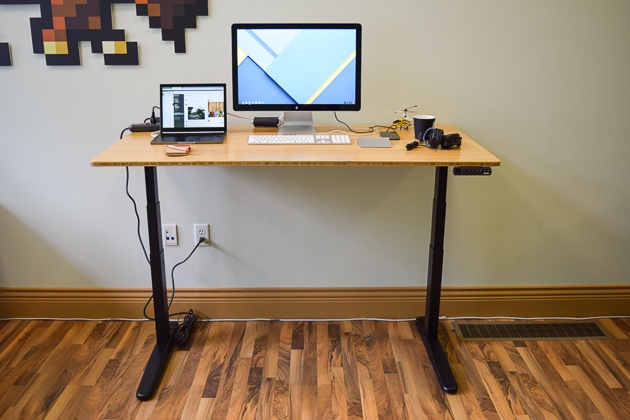 The answer to that question is unsurprisingly obvious, rather than taking a seat in order to be productive at your desk, the desk to place your equipment on is positioned higher, forcing you as a user to stand.
The answer to that question is unsurprisingly obvious, rather than taking a seat in order to be productive at your desk, the desk to place your equipment on is positioned higher, forcing you as a user to stand.
Stefan Molyneux, who has a prominent YouTube philosophy channel routinely stands for his presentations in order to improve his health. His production equipment is clearly mounted so that he can stand while working.
The purpose of these desks is to convert your ‘desk job’ into a standing job. They come in a variety of different set-ups and styles to suit everyone and the budgets reflect the range. From simply elevating the height of your laptop to a custom built workstation, they are becoming popular enough for there to be a product to suit everyone’s needs. See our round up of Australia’s best height adjustable desks for more options that might be suitable for your workspace.
Types of Standing Desks
Sit-To-Stand Adapters
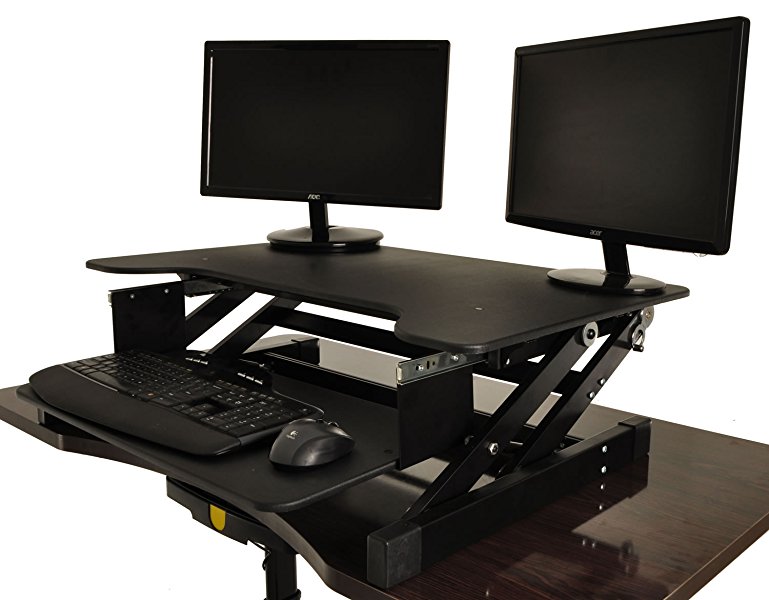
These are the simplest and easiest types of standing desks. They are merely a desk for your desk. These workstations sit on top of your existing desk in order to raise the height of the tools you need. They can be extremely simple to adjustable in height to produce an ideal workspace environment and have the additional advantage of you being able to alternate between sitting and standing rather than just picking one option.
Adaptors are an ideal place to start if you’d like to try out the idea. They are the most inexpensive option and are simple to add to your existing set-up. There are no real disadvantages but they do tend to be smaller and are thus limiting to the smaller work set-ups. If you work with a laptop it’s easier say than a full monitor and PC combo. Weight limits have to be respected.
Sit-To-Stand Adapters
These are the simplest and easiest types of standing desks. They are merely a desk for your desk. These workstations sit on top of your existing desk in order to raise the height of the tools you need. They can be extremely simple to adjustable in height to produce an ideal workspace environment and have the additional advantage of you being able to alternate between sitting and standing rather than just picking one option.
Adaptors are an ideal place to start if you’d like to try out the idea. They are the most inexpensive option and are simple to add to your existing set-up. There are no real disadvantages but they do tend to be smaller and are thus limiting to the smaller work set-ups. If you work with a laptop it’s easier say than a full monitor and PC combo. Weight limits have to be respected.

Fixed Standing Desks
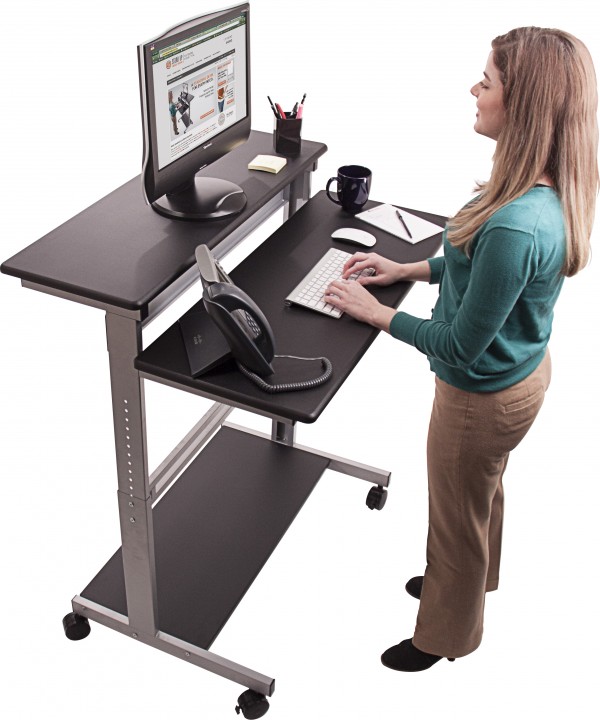
While the range is varied a fixed standing desk is a single one piece unit that, while being typically adjustable will lock into a fixed height position. They typically adjust up and down to take into account the range of human height differences. The minimum height though is usually designed so that it will not be able to be used for sitting, thus reducing the risk of the user pulling up a chair and defeating its purpose. A fixed height desk is normally sturdier and accommodates a larger range of typical workspaces, not just the users laptop.
An advantage is that you can add exercise equipment around the base such as a treadmill to increase functionality however, if you want to combine a standing and sitting workplace, you will need another desk. They are great however for short work moments where a laptop can be used or simple tasks need to be performed as everything can be to hand while standing and working.

Fixed Standing Desks
While the range is varied a fixed standing desk is a single one piece unit that, while being typically adjustable will lock into a fixed height position. They typically adjust up and down to take into account the range of human height differences. The minimum height though is usually designed so that it will not be able to be used for sitting, thus reducing the risk of the user pulling up a chair and defeating its purpose. A fixed height desk is normally sturdier and accommodates a larger range of typical workspaces, not just the users laptop.
An advantage is that you can add exercise equipment around the base such as a treadmill to increase functionality however, if you want to combine a standing and sitting workplace, you will need another desk. They are great however for short work moments where a laptop can be used or simple tasks need to be performed as everything can be to hand while standing and working.
Hand-Cranked (Adjustable) Sit-To-Stand Desks
These desks are ideal for the user who wants the option to both sit and stand at a work environment. While there are a range of mechanisms to convert the height of the worktop the simplest is the hand cranked model where you turn a crank to adjust the height and lock it into place. The desk itself does not move, merely the height of the station, thus you can alternate between sitting and standing while using the same workspace.
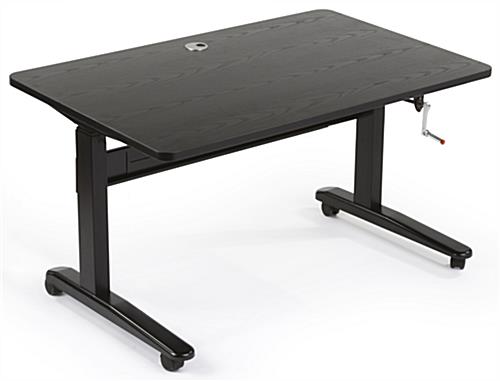
Hand-Cranked (Adjustable) Sit-To-Stand Desks

These desks are ideal for the user who wants the option to both sit and stand at a work environment. While there are a range of mechanisms to convert the height of the worktop the simplest is the hand cranked model where you turn a crank to adjust the height and lock it into place. The desk itself does not move, merely the height of the station, thus you can alternate between sitting and standing while using the same workspace.
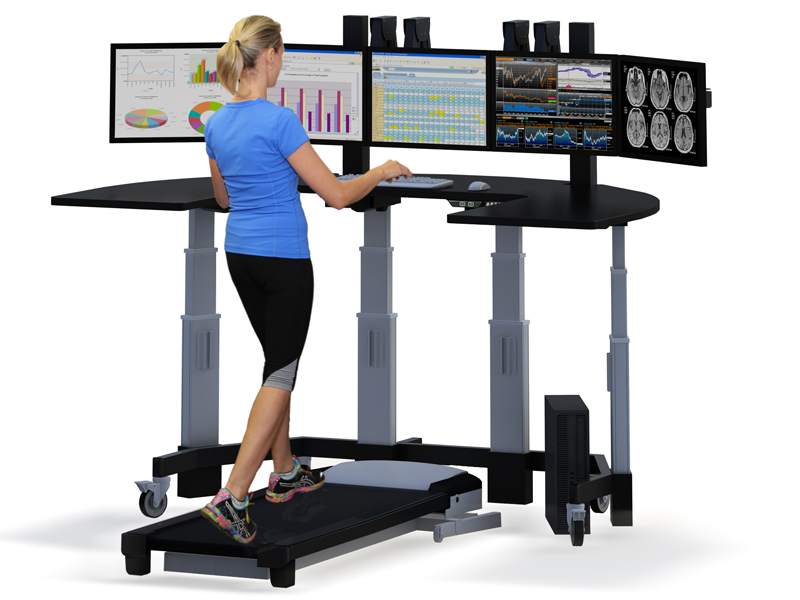
Hand-Cranked (Adjustable) Sit-To-Stand Desks
These desks are ideal for the user who wants the option to both sit and stand at a work environment. While there are a range of mechanisms to convert the height of the worktop the simplest is the hand cranked model where you turn a crank to adjust the height and lock it into place. The desk itself does not move, merely the height of the station, thus you can alternate between sitting and standing while using the same workspace.
Hand-Cranked (Adjustable) Sit-To-Stand Desks

These desks are ideal for the user who wants the option to both sit and stand at a work environment. While there are a range of mechanisms to convert the height of the worktop the simplest is the hand cranked model where you turn a crank to adjust the height and lock it into place. The desk itself does not move, merely the height of the station, thus you can alternate between sitting and standing while using the same workspace.
Are there health benefits?

Standing desks are not new. While they’ve been around for centuries there is a recent trend for their use that is rising. Thomas Jefferson and Winston Churchill are two individuals who almost exclusively worked at standing desks.
Thus rather than sitting all day staring into a monitor surely it would be better to stand, even occasionally while working.
One question that comes up a lot is when people are researching standing desks essentially revolves around calorie burning. The idea being that if you use a standing desk to work rather than sitting all day, how many extra calories will I burn?
In 2016 the Journal of Physical Activity and Health (https://www.ncbi.nlm.nih.gov/pubmed/26693809) conducted a study to answer that very question. The study, which used 74 healthy volunteers found that;
- While sitting, study subjects burned 80 calories/hour — about the same as typing or watching TV
- While standing, the number of calories burned was only slightly higher than while sitting — about 88 calories/hour
- Walking burned 210 calories/hour.
LOWERS BLOOD SUGAR
In a study completed in 2013 (https://www.ncbi.nlm.nih.gov/pubmed/24297826) that studied 10 workers (8 female) who stood for 185 minutes after having lunch found that there was a 43% dip in blood sugar levels compared to a test group that sat instead.
This reduces the risk of Type 2 diabetes. Interestingly they both took the same amount of steps around the office within the 185 minutes which strongly suggests the blood sugar effect comes from standing alone.

A similar study using 23 office workers (https://www.ncbi.nlm.nih.gov/pubmed/24637345) measured the effects measured over a whole working day. It found that just alternating between sitting and standing every 30 minutes on a regular basis can reduce blood sugar levels by around 11%.
These studies go a long way to explaining one of the symptoms of ‘sitting disease’ being an increased risk of Type 2 diabetes. If you are genetically or have a hereditary risk of these diseases then a standing desk may be a viable option to reduce your risk. As always, consult your doctor.
REDUCES BACK PAIN
Along with eye-strain, this is one of the more common complaints from workers who spend a significant amount of time sitting at their work-desks. As mentioned earlier, some studies have been conducted more recently to specifically look into the impacts of using a standing desk for positive health reasons.
While finding higher fatigue scores with those who sit all day it was noted that for those with long term back pain there was a 32% improvement in lower back pain and 54% reduced back pain with those using standing desks. These conditions were noted in less than a month of utilizing a standing desk. https://www.ncbi.nlm.nih.gov/pubmed/25168375 https://www.ncbi.nlm.nih.gov/pubmed/26735316
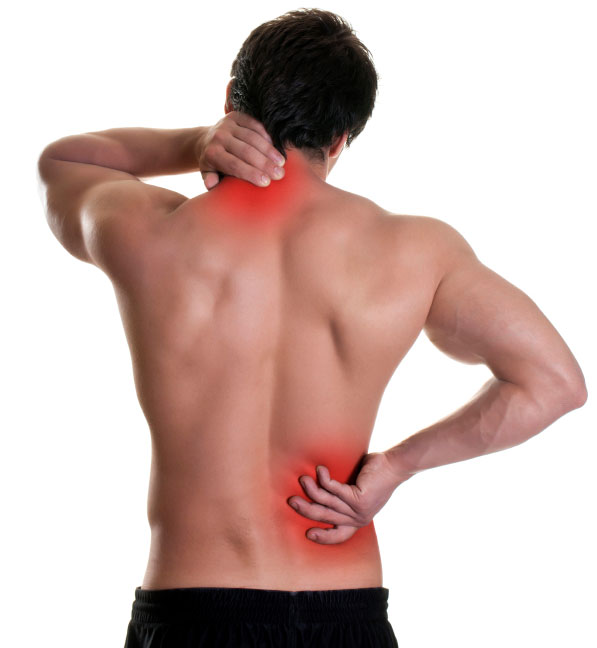
LOWER RISK OF HEART DISEASE
While standing too much at work has also been linked to increased risks of heart disease, which can alter significantly depending upon age and exercise undertaken, sitting too much can also increase risks. And these studies aren’t new.
A 1958 study (https://www.ncbi.nlm.nih.gov/pmc/articles/PMC2027542/) measured the differences of heart disease on bus conductors and the work colleagues, the bus drivers, who sat all day. It found that your risk of heart disease halved if you had the opportunity to stand up for extended periods.

More recent studies seem to add additional weight to these earlier studies, in that sitting down all day increase your risk of heart disease by up top 147% (https://www.ncbi.nlm.nih.gov/pubmed/22890825, http://circ.ahajournals.org/content/122/7/743.full).
It is now widely accepted in the medical fraternity that sitting down too much has a significant impact upon your health. Additionally it can be so harmful that periods of prolonged exercise may not reverse the effects.
IMPROVED MOOD AND ENERY LEVEL
In 2012, something called the ‘Take A Stand’ project based out of Minneapolis, Minnesota over a 7 week period sought to reduce sitting time at sedentary jobs by 66 minutes per day.
The project concluded that not only did it reduce back pain by 54% but improved mood states were observed.
What is also momentous is that upon completion of the project a reversal was noticed over a 2 week period to the pre project statistics.

BOOSTS PRODUCTIVITY
A lot of non users of standing desks have many concerns. There is a perception that sitting down one is more capable of performing tasks and thus you are more productive. In essence, you will find it difficult to type standing up.
A study in 2009 (https://www.ncbi.nlm.nih.gov/pubmed/19750794) sought to answer just such a question.
The study was performed with 60 males aged between 18 and 35 years of age and found that there was no difference in words typed per minute at a keyboard, Essentially there is no data productivity loss when utilizing a standing desk at the workplace. No doubt this is why Facebook, Google and Twitter already use standing desks.

MAY HELP YOU LONGER
With the increasing awareness that sitting down all day is having a detrimental effect on the health of workers in the world, studies have found a strong link between increased sitting time and early death.
It has been apparent to the medical words for years now that there is a strong association between sedentary time, type 2 diabetes and heart disease.
There are 2 studies that help prove this point;

Firstly, in 2012 a systemic review of studies (https://www.ncbi.nlm.nih.gov/pubmed/22890825) that sought to look at this concluded that there was a 49% greater chance of dying by those who sat than those who did not.
Also in 2012 (https://www.ncbi.nlm.nih.gov/pubmed/22777603) a study concluded that American life expectancy could be increased by 2 years if one could reduce the amount of time sitting by 3 hours a day. It found that ‘Reducing sedentary behaviours such as sitting and television viewing may have the potential to increase life expectancy in the USA.’
Conclusion
Whilst there is no substitute for a healthy diet and regular exercise, the solution of a standing desk to the ‘sitting disease’ does seem too interesting. With an increasing popularity and favourability amongst the tech giants for this approach to worker health it is certainly a viable option to the rest of us.
Whilst it is an individual choice and no-one should need to jump into a complete transition of using a standing desk to replace their current work day without a lot of research, it does seem reasonable to make a start with trying out working whilst standing in order to gain the benefits. It is well known that being inactive is unhealthy with increasing risks of disease and trying out a new style of working does seem prudent, if only for the benefit of your waistline and increased good moods.
References:
https://readwrite.com/2013/09/26/standing-desks-productivity/
http://www.sciencedirect.com/science/article/pii/S009174351400454X
https://www.fastcodesign.com/3045217/everything-science-knows-right-now-about-standing-desks
https://www.ncbi.nlm.nih.gov/pubmed/24297826
https://www.healthline.com/nutrition/7-benefits-of-a-standing-desk
https://www.prevention.com/health/benefits-of-standing-desk/slide/1
Standing Article Title
The problem
Are you sitting too much? The human body, through evolution is designed to move. This seems at odds with technological advancement in recent decades and the resulting increase in sedentary lifestyles that are being adopted.
For years, until the computer revolution the workplace was varied and by and large active. In the preceding years, motorized vehicles and TV’s began to replace cycling and sports as activities humans indulged in. This began a slow chipping away of physical activity in our daily lives.
In 2013, a survey performed by Ergotron found that around 70% of American, although they hated sitting, it was required for their vocation. From office workers to programmers, most of use a computer for work and this means the need to sit. This has led to a new adage, that ‘Sitting is the new Smoking’.
This new lifestyle reality is starting to get blamed for the increasing risks in our health, from obesity with the associated risks of heart disease and diabetes to the pains connected with bad posture. Health services recommend at least 150 minutes of exercise per week. A simple exercise such as walking has enormous health benefits. However, with 70% of us sitting down at work and the internet meaning you can message co-workers without needing to go and visit them that, after driving to work it’s not surprising that the number of people who do this is dropping.
Common sense should be able to tell you that these new lifestyle choices aren’t good for you. Common sense should also tell you that people have been searching for solutions.
Instead of working while sitting down there has been a growing trend in people starting to use standing desks in the last decade. Google searches for the term ‘standing desk’ have tripled in the last 12 months alone. Mega companies Twitter, Google and Facebook have started to offer standing desks as park of their employee wellness programs.
What is a standing desk?
The answer to that question is unsurprisingly obvious, rather than taking a seat in order to be productive at your desk, the desk to place your equipment on is positioned higher, forcing you as a user to stand.
Stefan Molyneux, who has a prominent YouTube philosophy channel routinely stands for his presentations in order to improve his health. His production equipment is clearly mounted so that he can stand while working.
The purpose of these desks is to convert your ‘desk job’ into a standing job. They come in a variety of different set-ups and styles to suit everyone and the budgets reflect the range. From simply elevating the height of your laptop to a custom built workstation, they are becoming popular enough for there to be a product to suit everyone’s needs.
Fixed Standing Desk
Sit-To-Stand Adapters
These are the simplest and easiest types of standing desks. They are merely a desk for your desk. These workstations sit on top of your existing desk in order to raise the height of the tools you need. They can be extremely simple to adjustable in height to produce an ideal workspace environment and have the additional advantage of you being able to alternate between sitting and standing rather than just picking one option.
Adaptors are an ideal place to start if you’d like to try out the idea. They are the most inexpensive option and are simple to add to your existing set-up. There are no real disadvantages but they do tend to be smaller and are thus limiting to the smaller work set-ups. If you work with a laptop it’s easier say than a full monitor and PC combo. Weight limits have to be respected.
Fixed Standing Desk
While the range is varied a fixed standing desk is a single one piece unit that, while being typically adjustable will lock into a fixed height position. They typically adjust up and down to take into account the range of human height differences. The minimum height though is usually designed so that it will not be able to be used for sitting, thus reducing the risk of the user pulling up a chair and defeating its purpose. A fixed height desk is normally sturdier and accommodates a larger range of typical workspaces, not just the users laptop.
An advantage is that you can add exercise equipment around the base such as a treadmill to increase functionality however, if you want to combine a standing and sitting workplace, you will need another desk. They are great however for short work moments where a laptop can be used or simple tasks need to be performed as everything can be to hand while standing and working.
Hand-Cranked (Adjustable) Sit-To-Stand Desks
These desks are ideal for the user who wants the option to both sit and stand at a work environment. While there are a range of mechanisms to convert the height of the worktop the simplest is the hand cranked model where you turn a crank to adjust the height and lock it into place. The desk itself does not move, merely the height of the station, thus you can alternate between sitting and standing while using the same workspace.
Exercise Desks
These are usually the most expensive of the available options and is a combination of a standing desk with some type of exercise machine, usually a walking treadmill or a cycling station that is coupled together. This creates a workspace where the user can multitask, both exercising and productively working in tandem.
While seemingly ideal, these options are quite bulky, so require a fair amount of floorspace. Additionally the additional movement might not lend itself well to typing or any work where finesse might be required. For scribbling notes it could be ideal but if you repair intricate watch mechanisms then it could well be a good idea to test this type of work station before a purchase. They are a product that might be better suited to a thorough testing for any individual’s requirements.
While ideal for some if you require a desk that you can sit as well, then detaching or dissembling the exercise machine might become cumbersome and laborious. The danger, although it has to be individually judged is that rather than being a compliment to each other you get two things that don’t quite work. As they tend to be the most expensive option then a thorough understanding of your requirements is a must.
Are there health benefits?
Standing desks are not new. While they’ve been around for centuries there is a recent trend for their use that is rising. Thomas Jefferson and Winston Churchill are two individuals who almost exclusively worked at standing desks.
Thus rather than sitting all day staring into a monitor surely it would be better to stand, even occasionally while working.
One question that comes up a lot is when people are researching standing desks essentially revolves around calorie burning. The idea being that if you use a standing desk to work rather than sitting all day, how many extra calories will I burn?
In 2016 the Journal of Physical Activity and Health (https://www.ncbi.nlm.nih.gov/pubmed/26693809) conducted a study to answer that very question. The study, which used 74 healthy volunteers found that;
1.) While sitting, study subjects burned 80 calories/hour — about the same as typing or watching TV
2.) While standing, the number of calories burned was only slightly higher than while sitting — about 88 calories/hour
3.) Walking burned 210 calories/hour.
To paraphrase, although standing burns a little more calories, far more calories are burnt through active movement. Fortunately, other studies have found that a standing desk increases the propensity to move around and thus burn more calories.
Although sitting for prolonged periods has been linked to obesity, diabetes, cardiovascular disease, cancer (especially cancers of the colon or breast) and premature death there have been several studies that have highlighted some key benefits to standing while working.
Since 2015 there have been 10 pier reviewed studies (http://www.juststand.org/the-facts/) designed to find the facts that we all ought to be aware of with our daily lives.
Lowers blood sugar levels –
In a study completed in 2013 (https://www.ncbi.nlm.nih.gov/pubmed/24297826) that studied 10 workers (8 female) who stood for 185 minutes after having lunch found that there was a 43% dip in blood sugar levels compared to a test group that sat instead. This reduces the risk of Type 2 diabetes
Interestingly they both took the same amount of steps around the office within the 185 minutes which strongly suggests the blood sugar effect comes from standing alone.
A similar study using 23 office workers (https://www.ncbi.nlm.nih.gov/pubmed/24637345) measured the effects measured over a whole working day. It found that just alternating between sitting and standing every 30 minutes on a regular basis can reduce blood sugar levels by around 11%.
These studies go a long way to explaining one of the symptoms of ‘sitting disease’ being an increased risk of Type 2 diabetes. If you are genetically or have a hereditary risk of these diseases then a standing desk may be a viable option to reduce your risk. As always, consult your doctor.
Lowers risk of heart disease –
While standing too much at work has also been linked to increased risks of heart disease, which can alter significantly depending upon age and exercise undertaken, sitting too much can also increase risks. And these studies aren’t new.
A 1958 study (https://www.ncbi.nlm.nih.gov/pmc/articles/PMC2027542/) measured the differences of heart disease on bus conductors and the work colleagues, the bus drivers, who sat all day. It found that your risk of heart disease halved if you had the opportunity to stand up for extended periods.
More recent studies seem to add additional weight to these earlier studies, in that sitting down all day increase your risk of heart disease by up top 147% (https://www.ncbi.nlm.nih.gov/pubmed/22890825, http://circ.ahajournals.org/content/122/7/743.full).
It is now widely accepted in the medical fraternity that sitting down too much has a significant impact upon your health. Additionally it can be so harmful that periods of prolonged exercise may not reverse the effects.
Reduces back pain –
Along with eye-strain, this is one of the more common complaints from workers who spend a significant amount of time sitting at their work-desks.
As mentioned earlier, some studies have been conducted more recently to specifically look into the impacts of using a standing desk for positive health reasons.
While finding higher fatigue scores with those who sit all day it was noted that for those with long term back pain there was a 32% improvement in lower back pain and 54% reduced back pain with those using standing desks. These conditions were noted in less than a month of utilizing a standing desk.
https://www.ncbi.nlm.nih.gov/pubmed/25168375
https://www.ncbi.nlm.nih.gov/pubmed/26735316
Improved mood and Energy levels –
In 2012, something called the ‘Take A Stand’ project based out of Minneapolis, Minnesota over a 7 week period sought to reduce sitting time at sedentary jobs by 66 minutes per day.
The project concluded that not only did it reduce back pain by 54% but improved mood states were observed.
What is also momentous is that upon completion of the project a reversal was noticed over a 2 week period to the pre project statistics.
Boosts Productivity –
A lot of non users of standing desks have many concerns. There is a perception that sitting down one is more capable of performing tasks and thus you are more productive. In essence, you will find it difficult to type standing up.
A study in 2009 (https://www.ncbi.nlm.nih.gov/pubmed/19750794) sought to answer just such a question.
The study was performed with 60 males aged between 18 and 35 years of age and found that there was no difference in words typed per minute at a keyboard, Essentially there is no data productivity loss when utilizing a standing desk at the workplace. No doubt this is why Facebook, Google and Twitter already use standing desks.
May help you live longer –
With the increasing awareness that sitting down all day is having a detrimental effect on the health of workers in the world, studies have found a strong link between increased sitting time and early death.
It has been apparent to the medical words for years now that there is a strong association between sedentary time, type 2 diabetes and heart disease.
There are 2 studies that help prove this point;
Firstly, in 2012 a systemic review of studies (https://www.ncbi.nlm.nih.gov/pubmed/22890825) that sought to look at this concluded that there was a 49% greater chance of dying by those who sat than those who did not.
Also in 2012 (https://www.ncbi.nlm.nih.gov/pubmed/22777603) a study concluded that American life expectancy could be increased by 2 years if one could reduce the amount of time sitting by 3 hours a day. It found that ‘Reducing sedentary behaviours such as sitting and television viewing may have the potential to increase life expectancy in the USA.’
Conclusion
Whilst there is no substitute for a healthy diet and regular exercise, the solution of a standing desk to the ‘sitting disease’ does seem to interesting. With an increasing popularity and favourability amongst the tech giants for this approach to worker health it is certainly a viable option to the rest of us.
Whilst it is an individual choice and no-one should need to jump into a complete transition of using a standing desk to replace their current work day without a lot of research, it does seem reasonable to make a start with trying out working whilst standing in order to gain the benefits. It is well known that being inactive is unhealthy with increasing risks of disease and trying out a new style of working does seem prudent, if only for the benefit of your waistline and increased good moods.
https://readwrite.com/2013/09/26/standing-desks-productivity/
http://www.sciencedirect.com/science/article/pii/S009174351400454X
https://www.fastcodesign.com/3045217/everything-science-knows-right-now-about-standing-desks
https://www.ncbi.nlm.nih.gov/pubmed/24297826
https://www.healthline.com/nutrition/7-benefits-of-a-standing-desk
https://www.prevention.com/health/benefits-of-standing-desk/slide/1
Standing Article Title
The problem
Are you sitting too much? The human body, through evolution is designed to move. This seems at odds with technological advancement in recent decades and the resulting increase in sedentary lifestyles that are being adopted.
For years, until the computer revolution the workplace was varied and by and large active. In the preceding years, motorized vehicles and TV’s began to replace cycling and sports as activities humans indulged in. This began a slow chipping away of physical activity in our daily lives.
In 2013, a survey performed by Ergotron found that around 70% of American, although they hated sitting, it was required for their vocation. From office workers to programmers, most of use a computer for work and this means the need to sit. This has led to a new adage, that ‘Sitting is the new Smoking’.
This new lifestyle reality is starting to get blamed for the increasing risks in our health, from obesity with the associated risks of heart disease and diabetes to the pains connected with bad posture. Health services recommend at least 150 minutes of exercise per week. A simple exercise such as walking has enormous health benefits. However, with 70% of us sitting down at work and the internet meaning you can message co-workers without needing to go and visit them that, after driving to work it’s not surprising that the number of people who do this is dropping.
Common sense should be able to tell you that these new lifestyle choices aren’t good for you. Common sense should also tell you that people have been searching for solutions.
Instead of working while sitting down there has been a growing trend in people starting to use standing desks in the last decade. Google searches for the term ‘standing desk’ have tripled in the last 12 months alone. Mega companies Twitter, Google and Facebook have started to offer standing desks as park of their employee wellness programs.
What is a standing desk?
The answer to that question is unsurprisingly obvious, rather than taking a seat in order to be productive at your desk, the desk to place your equipment on is positioned higher, forcing you as a user to stand.
Stefan Molyneux, who has a prominent YouTube philosophy channel routinely stands for his presentations in order to improve his health. His production equipment is clearly mounted so that he can stand while working.
The purpose of these desks is to convert your ‘desk job’ into a standing job. They come in a variety of different set-ups and styles to suit everyone and the budgets reflect the range. From simply elevating the height of your laptop to a custom built workstation, they are becoming popular enough for there to be a product to suit everyone’s needs.
Types of Standing Desks
Sit-To-Stand Adapters
These are the simplest and easiest types of standing desks. They are merely a desk for your desk. These workstations sit on top of your existing desk in order to raise the height of the tools you need. They can be extremely simple to adjustable in height to produce an ideal workspace environment and have the additional advantage of you being able to alternate between sitting and standing rather than just picking one option.
Adaptors are an ideal place to start if you’d like to try out the idea. They are the most inexpensive option and are simple to add to your existing set-up. There are no real disadvantages but they do tend to be smaller and are thus limiting to the smaller work set-ups. If you work with a laptop it’s easier say than a full monitor and PC combo. Weight limits have to be respected.
Fixed Standing Desks
While the range is varied a fixed standing desk is a single one piece unit that, while being typically adjustable will lock into a fixed height position. They typically adjust up and down to take into account the range of human height differences. The minimum height though is usually designed so that it will not be able to be used for sitting, thus reducing the risk of the user pulling up a chair and defeating its purpose. A fixed height desk is normally sturdier and accommodates a larger range of typical workspaces, not just the users laptop.
An advantage is that you can add exercise equipment around the base such as a treadmill to increase functionality however, if you want to combine a standing and sitting workplace, you will need another desk. They are great however for short work moments where a laptop can be used or simple tasks need to be performed as everything can be to hand while standing and working.
Hand-Cranked (Adjustable) Sit-To-Stand Desks
These desks are ideal for the user who wants the option to both sit and stand at a work environment. While there are a range of mechanisms to convert the height of the worktop the simplest is the hand cranked model where you turn a crank to adjust the height and lock it into place. The desk itself does not move, merely the height of the station, thus you can alternate between sitting and standing while using the same workspace.
Exercise Desks
These are usually the most expensive of the available options and is a combination of a standing desk with some type of exercise machine, usually a walking treadmill or a cycling station that is coupled together. This creates a workspace where the user can multitask, both exercising and productively working in tandem.
While seemingly ideal, these options are quite bulky, so require a fair amount of floorspace. Additionally the additional movement might not lend itself well to typing or any work where finesse might be required. For scribbling notes it could be ideal but if you repair intricate watch mechanisms then it could well be a good idea to test this type of work station before a purchase. They are a product that might be better suited to a thorough testing for any individual’s requirements.
While ideal for some if you require a desk that you can sit as well, then detaching or dissembling the exercise machine might become cumbersome and laborious. The danger, although it has to be individually judged is that rather than being a compliment to each other you get two things that don’t quite work. As they tend to be the most expensive option then a thorough understanding of your requirements is a must.
Are there health benefits?
Standing desks are not new. While they’ve been around for centuries there is a recent trend for their use that is rising. Thomas Jefferson and Winston Churchill are two individuals who almost exclusively worked at standing desks.
Thus rather than sitting all day staring into a monitor surely it would be better to stand, even occasionally while working.
One question that comes up a lot is when people are researching standing desks essentially revolves around calorie burning. The idea being that if you use a standing desk to work rather than sitting all day, how many extra calories will I burn?
In 2016 the Journal of Physical Activity and Health (https://www.ncbi.nlm.nih.gov/pubmed/26693809) conducted a study to answer that very question. The study, which used 74 healthy volunteers found that;
1.) While sitting, study subjects burned 80 calories/hour — about the same as typing or watching TV
2.) While standing, the number of calories burned was only slightly higher than while sitting — about 88 calories/hour
3.) Walking burned 210 calories/hour.
To paraphrase, although standing burns a little more calories, far more calories are burnt through active movement. Fortunately, other studies have found that a standing desk increases the propensity to move around and thus burn more calories.
Although sitting for prolonged periods has been linked to obesity, diabetes, cardiovascular disease, cancer (especially cancers of the colon or breast) and premature death there have been several studies that have highlighted some key benefits to standing while working.
Since 2015 there have been 10 pier reviewed studies (http://www.juststand.org/the-facts/) designed to find the facts that we all ought to be aware of with our daily lives.
Lowers blood sugar levels –
In a study completed in 2013 (https://www.ncbi.nlm.nih.gov/pubmed/24297826) that studied 10 workers (8 female) who stood for 185 minutes after having lunch found that there was a 43% dip in blood sugar levels compared to a test group that sat instead. This reduces the risk of Type 2 diabetes
Interestingly they both took the same amount of steps around the office within the 185 minutes which strongly suggests the blood sugar effect comes from standing alone.
A similar study using 23 office workers (https://www.ncbi.nlm.nih.gov/pubmed/24637345) measured the effects measured over a whole working day. It found that just alternating between sitting and standing every 30 minutes on a regular basis can reduce blood sugar levels by around 11%.
These studies go a long way to explaining one of the symptoms of ‘sitting disease’ being an increased risk of Type 2 diabetes. If you are genetically or have a hereditary risk of these diseases then a standing desk may be a viable option to reduce your risk. As always, consult your doctor.
Lowers risk of heart disease –
While standing too much at work has also been linked to increased risks of heart disease, which can alter significantly depending upon age and exercise undertaken, sitting too much can also increase risks. And these studies aren’t new.
A 1958 study (https://www.ncbi.nlm.nih.gov/pmc/articles/PMC2027542/) measured the differences of heart disease on bus conductors and the work colleagues, the bus drivers, who sat all day. It found that your risk of heart disease halved if you had the opportunity to stand up for extended periods.
More recent studies seem to add additional weight to these earlier studies, in that sitting down all day increase your risk of heart disease by up top 147% (https://www.ncbi.nlm.nih.gov/pubmed/22890825, http://circ.ahajournals.org/content/122/7/743.full).
It is now widely accepted in the medical fraternity that sitting down too much has a significant impact upon your health. Additionally it can be so harmful that periods of prolonged exercise may not reverse the effects.
Reduces back pain –
Along with eye-strain, this is one of the more common complaints from workers who spend a significant amount of time sitting at their work-desks.
As mentioned earlier, some studies have been conducted more recently to specifically look into the impacts of using a standing desk for positive health reasons.
While finding higher fatigue scores with those who sit all day it was noted that for those with long term back pain there was a 32% improvement in lower back pain and 54% reduced back pain with those using standing desks. These conditions were noted in less than a month of utilizing a standing desk.
https://www.ncbi.nlm.nih.gov/pubmed/25168375
https://www.ncbi.nlm.nih.gov/pubmed/26735316
Improved mood and Energy levels –
In 2012, something called the ‘Take A Stand’ project based out of Minneapolis, Minnesota over a 7 week period sought to reduce sitting time at sedentary jobs by 66 minutes per day.
The project concluded that not only did it reduce back pain by 54% but improved mood states were observed.
What is also momentous is that upon completion of the project a reversal was noticed over a 2 week period to the pre project statistics.
Boosts Productivity –
A lot of non users of standing desks have many concerns. There is a perception that sitting down one is more capable of performing tasks and thus you are more productive. In essence, you will find it difficult to type standing up.
A study in 2009 (https://www.ncbi.nlm.nih.gov/pubmed/19750794) sought to answer just such a question.
The study was performed with 60 males aged between 18 and 35 years of age and found that there was no difference in words typed per minute at a keyboard, Essentially there is no data productivity loss when utilizing a standing desk at the workplace. No doubt this is why Facebook, Google and Twitter already use standing desks.
May help you live longer –
With the increasing awareness that sitting down all day is having a detrimental effect on the health of workers in the world, studies have found a strong link between increased sitting time and early death.
It has been apparent to the medical words for years now that there is a strong association between sedentary time, type 2 diabetes and heart disease.
There are 2 studies that help prove this point;
Firstly, in 2012 a systemic review of studies (https://www.ncbi.nlm.nih.gov/pubmed/22890825) that sought to look at this concluded that there was a 49% greater chance of dying by those who sat than those who did not.
Also in 2012 (https://www.ncbi.nlm.nih.gov/pubmed/22777603) a study concluded that American life expectancy could be increased by 2 years if one could reduce the amount of time sitting by 3 hours a day. It found that ‘Reducing sedentary behaviours such as sitting and television viewing may have the potential to increase life expectancy in the USA.’
Conclusion
Whilst there is no substitute for a healthy diet and regular exercise, the solution of a standing desk to the ‘sitting disease’ does seem to interesting. With an increasing popularity and favourability amongst the tech giants for this approach to worker health it is certainly a viable option to the rest of us.
Whilst it is an individual choice and no-one should need to jump into a complete transition of using a standing desk to replace their current work day without a lot of research, it does seem reasonable to make a start with trying out working whilst standing in order to gain the benefits. It is well known that being inactive is unhealthy with increasing risks of disease and trying out a new style of working does seem prudent, if only for the benefit of your waistline and increased good moods.
https://readwrite.com/2013/09/26/standing-desks-productivity/
http://www.sciencedirect.com/science/article/pii/S009174351400454X
https://www.fastcodesign.com/3045217/everything-science-knows-right-now-about-standing-desks
https://www.ncbi.nlm.nih.gov/pubmed/24297826
https://www.healthline.com/nutrition/7-benefits-of-a-standing-desk
https://www.prevention.com/health/benefits-of-standing-desk/slide/1



